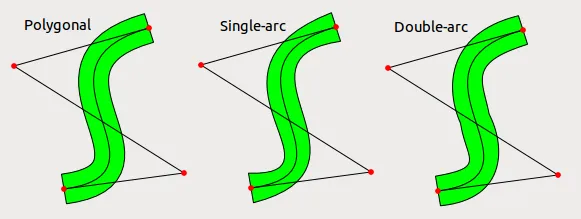从数学角度来看,贝塞尔曲线的精确平行线非常丑陋(需要10次多项式)。
容易做到的是,计算出贝塞尔曲线的多边形近似的扩展宽度(即从贝塞尔曲线计算出线段,然后沿着曲线两侧的法线移动点)。
如果您的厚度与曲率不太大,这会产生良好的结果...而“远离平行线”则是一个独立的怪物(甚至很难找到一个关于开放曲线的平行线的定义,能让每个人都满意)。
一旦您有了两条多边形的路径,您可以为这些路径中的每一条找到最佳逼近的贝塞尔曲线,如果您需要该表示法。再次强调,我认为对于“正常情况”(即相当薄的线条),甚至每侧只需一个贝塞尔弧就应该相当准确(误差应该比线条的厚度小得多)。
编辑:事实上,即使对于相当正常的情况,使用单个贝塞尔弧的效果也比我预期的要差得多。我还尝试了为每侧使用两个贝塞尔弧,结果更好但仍然不完美。误差当然比线条的厚度小得多,因此除非线条非常粗,否则这可能是一个合理的选择。下图显示了加粗的贝塞尔曲线(每点加粗),每侧使用单个贝塞尔弧的近似值以及每侧使用两个贝塞尔曲线的近似值。

编辑2:根据要求,我添加了获取图片所使用的Python代码,它只需要Qt。这段代码并不是为其他人编写的,因此我使用了一些技巧,可能在实际生产代码中不会使用。该算法也非常低效,但我并不关心速度(这只是一个一次性程序,用于测试想法是否可行)。
import sys
from PyQt4.Qt import *
QW = QWidget
bezlevels = 5
def avg(a, b):
"""Average of two (x, y) points"""
xa, ya = a
xb, yb = b
return ((xa + xb)*0.5, (ya + yb)*0.5)
def bez3split(p0, p1, p2,p3):
"""
Given the control points of a bezier cubic arc computes the
control points of first and second half
"""
p01 = avg(p0, p1)
p12 = avg(p1, p2)
p23 = avg(p2, p3)
p012 = avg(p01, p12)
p123 = avg(p12, p23)
p0123 = avg(p012, p123)
return [(p0, p01, p012, p0123),
(p0123, p123, p23, p3)]
def bez3(p0, p1, p2, p3, levels=bezlevels):
"""
Builds a bezier cubic arc approximation using a fixed
number of half subdivisions.
"""
if levels <= 0:
return [p0, p3]
else:
(a0, a1, a2, a3), (b0, b1, b2, b3) = bez3split(p0, p1, p2, p3)
return (bez3(a0, a1, a2, a3, levels-1) +
bez3(b0, b1, b2, b3, levels-1)[1:])
def thickPath(pts, d):
"""
Given a polyline and a distance computes an approximation
of the two one-sided offset curves and returns it as two
polylines with the same number of vertices as input.
NOTE: Quick and dirty approach, just uses a "normal" for every
vertex computed as the perpendicular to the segment joining
the previous and next vertex.
No checks for self-intersections (those happens when the
distance is too big for the local curvature), and no check
for degenerate input (e.g. multiple points).
"""
l1 = []
l2 = []
for i in xrange(len(pts)):
i0 = max(0, i - 1)
i1 = min(len(pts) - 1, i + 1)
x, y = pts[i]
x0, y0 = pts[i0]
x1, y1 = pts[i1]
dx = x1 - x0
dy = y1 - y0
L = (dx**2 + dy**2) ** 0.5
nx = - d*dy / L
ny = d*dx / L
l1.append((x - nx, y - ny))
l2.append((x + nx, y + ny))
return l1, l2
def dist2(x0, y0, x1, y1):
"Squared distance between two points"
return (x1 - x0)**2 + (y1 - y0)**2
def dist(x0, y0, x1, y1):
"Distance between two points"
return ((x1 - x0)**2 + (y1 - y0)**2) ** 0.5
def ibez(pts, levels=bezlevels):
"""
Inverse-bezier computation.
Given a list of points computes the control points of a
cubic bezier arc that approximates them.
"""
x0, y0 = pts[0]
x3, y3 = pts[-1]
x1, y1 = (x0*3 + x3) / 4.0, (y0*3 + y3) / 4.0
x2, y2 = (x0 + x3*3) / 4.0, (y0 + y3*3) / 4.0
L = sum(dist(*(pts[i] + pts[i-1])) for i in xrange(len(pts) - 1))
step = L / 10
limit = step / 100
def err(x0, y0, x1, y1, x2, y2, x3, y3):
return max(dist2(*(x+p)) for x, p in zip(pts, bez3((x0, y0), (x1, y1),
(x2, y2), (x3, y3),
levels)))
while step > limit:
best = None
for dx1 in (-step, 0, step):
for dy1 in (-step, 0, step):
for dx2 in (-step, 0, step):
for dy2 in (-step, 0, step):
e = err(x0, y0,
x1+dx1, y1+dy1,
x2+dx2, y2+dy2,
x3, y3)
if best is None or e < best[0] * 0.9999:
best = e, dx1, dy1, dx2, dy2
e, dx1, dy1, dx2, dy2 = best
if (dx1, dy1, dx2, dy2) == (0, 0, 0, 0):
step *= 0.5
else:
x1 += dx1
y1 += dy1
x2 += dx2
y2 += dy2
return [(x0, y0), (x1, y1), (x2, y2), (x3, y3)]
def poly(pts):
"Converts a list of (x, y) points to a QPolygonF)"
return QPolygonF(map(lambda p: QPointF(*p), pts))
class Viewer(QW):
def __init__(self, parent):
QW.__init__(self, parent)
self.pts = [(100, 100), (200, 100), (200, 200), (100, 200)]
self.tracking = None
self.ibez = 0
def sizeHint(self):
return QSize(900, 700)
def wheelEvent(self, e):
self.ibez = (self.ibez + 1) % 3
self.update()
def paintEvent(self, e):
dc = QPainter(self)
dc.setRenderHints(QPainter.Antialiasing)
pts = bez3(*self.pts)
l1, l2 = thickPath(pts, 15)
if self.ibez == 1:
l1 = bez3(*ibez(l1))
l2 = bez3(*ibez(l2))
elif self.ibez == 2:
l1 = (bez3(*ibez(l1[:len(l1)/2+1], bezlevels-1)) +
bez3(*ibez(l1[len(l1)/2:], bezlevels-1))[1:])
l2 = (bez3(*ibez(l2[:len(l2)/2+1], bezlevels-1)) +
bez3(*ibez(l2[len(l2)/2:], bezlevels-1))[1:])
dc.setBrush(QBrush(QColor(0, 255, 0)))
dc.drawPolygon(poly(l1 + l2[::-1]))
dc.drawPolyline(poly(pts))
dc.drawPolyline(poly(self.pts))
dc.setBrush(QBrush(QColor(255, 0, 0)))
dc.setPen(QPen(Qt.NoPen))
for x, y in self.pts:
dc.drawEllipse(QRectF(x-3, y-3, 6, 6))
dc.setPen(QPen(QColor(0, 0, 0)))
dc.drawText(20, 20,
["Polygonal", "Single-arc", "Double-arc"][self.ibez])
def mousePressEvent(self, e):
i = min(range(len(self.pts)),
key=lambda i: (e.x() - self.pts[i][0])**2 +
(e.y() - self.pts[i][1])**2)
self.tracking = lambda p: self.pts.__setitem__(i, p)
def mouseMoveEvent(self, e):
if self.tracking:
self.tracking((e.x(), e.y()))
self.update()
def mouseReleaseEvent(self, e):
self.tracking = None
class MyDialog(QDialog):
def __init__(self, parent):
QDialog.__init__(self, parent)
self.ws = Viewer(self)
L = QVBoxLayout(self)
L.addWidget(self.ws)
self.setModal(True)
self.show()
app = QApplication([])
aa = MyDialog(None)
aa.exec_()
aa = None
